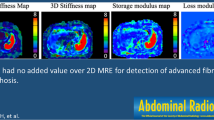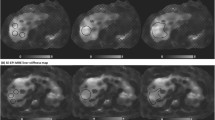Abstract
Purpose
To compare MR hepatic fractional extracellular space (fECS) to liver stiffness (LS) with magnetic resonance elastography (MRE) for evaluation of liver fibrosis.
Methods and materials
71 consecutive patients with suspected chronic liver disease underwent standard liver MRI with MR elastography and additional delayed Gd-DTPA-enhanced sequences at 5 and 10 min in order to calculate hepatic fECS (%) and LS (kilopascals, kPa). Two radiologists blinded to clinical history examined MR images and calculated fECS and LS in identical locations for every patient. Interobserver agreement was calculated using the intraclass correlation coefficient. Pearson’s correlation was calculated for LS and fECS measures, as was the area under the receiver operatic curve (AUROC), sensitivity and specificity of fECS to predict liver stiffness ≥2.93 and ≥5 kPa. The sensitivity of fECS for detecting fibrosis was separately analyzed in the subgroup of patients without anatomic findings of cirrhosis.
Results
Substantial to excellent interobserver agreement for both LS and fECS measurements was seen with intraclass correlation of 0.88 (95% CI 0.81–0.92) for LS, 0.77 (95% CI 0.66–0.85) for fECS5 and 0.76 (95% CI 0.64–0.84) for fECS10. A significant correlation was found between MRE and fECS5 (r = 0.47, p < 0.0001) and fECS10 (r = 0.44, p < 0.0001). The performance of fECS improved for detection of advanced fibrosis (≥5 kPa) with AUROC, sensitivity and specificity of 0.72, 38%, and 94% for fECS5 and 0.72, 67%, and 66% for fECS10.
Conclusion
fECS correlates modestly with MRE-determined LS. fECS at MRI is a simple calculation to perform and may represent a practical way to suggest the presence of fibrosis during routine liver evaluation.




Similar content being viewed by others
References
Lim YS, Kim WR (2008) The global impact of hepatic fibrosis and end-stage liver disease. Clin Liver Dis 12(4):733–746. doi:10.1016/j.cld.2008.07.007
Lee YA, Friedman SL (2014) Reversal, maintenance or progression: what happens to the liver after a virologic cure of hepatitis C? Antivir Res 107:23–30. doi:10.1016/j.antiviral.2014.03.012
Schuppan D, Afdhal NH (2008) Liver cirrhosis. Lancet 371(9615):838–851. doi:10.1016/S0140-6736(08)60383-9
Bedossa P (2015) Reversibility of hepatitis B virus cirrhosis after therapy: who and why? Liver Int 35(Suppl 1):78–81. doi:10.1111/liv.12710
Venkatesh SK, Yin M, Ehman RL (2013) Magnetic resonance elastography of liver: clinical applications. J Comput Assist Tomogr 37(6):887–896. doi:10.1097/RCT.0000000000000032
Rousselet MC, Michalak S, Dupre F, et al. (2005) Sources of variability in histological scoring of chronic viral hepatitis. Hepatology 41(2):257–264. doi:10.1002/hep.20535
Venkatesh SK, Yin M, Takahashi N, et al. (2015) Non-invasive detection of liver fibrosis: MR imaging features vs MR elastography. Abdom Imaging 40(4):766–775. doi:10.1007/s00261-015-0347-6
Bonekamp S, Kamel I, Solga S, Clark J (2009) Can imaging modalities diagnose and stage hepatic fibrosis and cirrhosis accurately? J Hepatol 50(1):17–35. doi:10.1016/j.jhep.2008.10.016
Rustogi R, Horowitz J, Harmath C, et al. (2012) Accuracy of MR elastography and anatomic MR imaging features in the diagnosis of severe hepatic fibrosis and cirrhosis. J Magn Reson Imaging 35(6):1356–1364. doi:10.1002/jmri.23585
Bonekamp D, Bonekamp S, Geiger B, Kamel IR (2012) An elevated arterial enhancement fraction is associated with clinical and imaging indices of liver fibrosis and cirrhosis. J Comput Assist Tomogr 36(6):681–689. doi:10.1097/RCT.0b013e3182702ee3
Ou HY, Bonekamp S, Bonekamp D, et al. (2013) MRI arterial enhancement fraction in hepatic fibrosis and cirrhosis. AJR Am J Roentgenol 201(4):W596–W602. doi:10.2214/AJR.12.10048
Singh S, Venkatesh SK, Wang Z, et al. (2015) Diagnostic performance of magnetic resonance elastography in staging liver fibrosis: a systematic review and meta-analysis of individual participant data. Clin Gastroenterol Hepatol 13(3):440–451. doi:10.1016/j.cgh.2014.09.046
Venkatesh SK, Yin M, Ehman RL (2013) Magnetic resonance elastography of liver: technique, analysis, and clinical applications. J Magn Reson Imaging 37(3):544–555. doi:10.1002/jmri.23731
Ichikawa S, Motosugi U, Morisaka H, et al. (2015) Comparison of the diagnostic accuracies of magnetic resonance elastography and transient elastography for hepatic fibrosis. Magn Reson Imaging 33(1):26–30. doi:10.1016/j.mri.2014.10.003
Dyvorne HA, Jajamovich GH, Bane O, et al. (2016) Prospective comparison of magnetic resonance imaging to transient elastography and serum markers for liver fibrosis detection. Liver Int 36(5):659–666. doi:10.1111/liv.13058
Venkatesh SK, Ehman RL (2014) Magnetic resonance elastography of liver. Magn Reson Imaging Clin N Am 22(3):433–446. doi:10.1016/j.mric.2014.05.001
Varenika V, Fu Y, Maher JJ, et al. (2013) Hepatic fibrosis: evaluation with semiquantitative contrast-enhanced CT. Radiology 266(1):151–158. doi:10.1148/radiol.12112452
Zissen MH, Wang ZJ, Yee J, et al. (2013) Contrast-enhanced CT quantification of the hepatic fractional extracellular space: correlation with diffuse liver disease severity. AJR Am J Roentgenol 201(6):1204–1210. doi:10.2214/AJR.12.10039
Bandula S, Punwani S, Rosenberg WM, et al. (2015) Equilibrium contrast-enhanced CT imaging to evaluate hepatic fibrosis: initial validation by comparison with histopathologic sampling. Radiology 275(1):136–143. doi:10.1148/radiol.14141435
Yoon JH, Lee JM, Klotz E, et al. (2015) Estimation of hepatic extracellular volume fraction using multiphasic liver computed tomography for hepatic fibrosis grading. Invest Radiol 50(4):290–296. doi:10.1097/RLI.0000000000000123
Flett AS, Hayward MP, Ashworth MT, et al. (2010) Equilibrium contrast cardiovascular magnetic resonance for the measurement of diffuse myocardial fibrosis: preliminary validation in humans. Circulation 122(2):138–144. doi:10.1161/CIRCULATIONAHA.109.930636
Kellman P, Wilson JR, Xue H, Ugander M, Arai AE (2012) Extracellular volume fraction mapping in the myocardium, part 1: evaluation of an automated method. J Cardiovasc Magn Reson 14:63. doi:10.1186/1532-429X-14-63
Bandula S, Banypersad SM, Sado D, et al. (2013) Measurement of Tissue interstitial volume in healthy patients and those with amyloidosis with equilibrium contrast-enhanced MR imaging. Radiology 268(3):858–864. doi:10.1148/radiol.13121889
Aime S, Caravan P (2009) Biodistribution of gadolinium-based contrast agents, including gadolinium deposition. J Magn Reson Imaging 30(6):1259–1267. doi:10.1002/jmri.21969
Landis JR, Koch GG (1977) The measurement of observer agreement for categorical data. Biometrics 33(1):159–174
Cademartiri F, Mollet NR, van der Lugt A, et al. (2005) Intravenous contrast material administration at helical 16-detector row CT coronary angiography: effect of iodine concentration on vascular attenuation. Radiology 236(2):661–665. doi:10.1148/radiol.2362040468
Materne R, Smith AM, Peeters F, et al. (2002) Assessment of hepatic perfusion parameters with dynamic MRI. Magn Reson Med 47(1):135–142
Martini C, Maffei E, Palumbo A, et al. (2010) Impact of contrast material volume on quantitative assessment of reperfused acute myocardial infarction using delayed-enhancement 64-slice CT: experience in a porcine model. La Radiologia medica 115(1):22–35. doi:10.1007/s11547-009-0481-8
Van Beers BE, Leconte I, Materne R, et al. (2001) Hepatic perfusion parameters in chronic liver disease: dynamic CT measurements correlated with disease severity. AJR Am J Roentgenol 176(3):667–673. doi:10.2214/ajr.176.3.1760667
Klein C, Schmal TR, Nekolla SG, et al. (2007) Mechanism of late gadolinium enhancement in patients with acute myocardial infarction. J Cardiovasc Magn Reson 9(4):653–658. doi:10.1080/10976640601105614
Aguirre DA, Behling CA, Alpert E, Hassanein TI, Sirlin CB (2006) Liver fibrosis: noninvasive diagnosis with double contrast material-enhanced MR imaging. Radiology 239(2):425–437. doi:10.1148/radiol.2392050505
Martin DR, Lauenstein T, Kalb B, et al. (2012) Liver MRI and histological correlates in chronic liver disease on multiphase gadolinium-enhanced 3D gradient echo imaging. J Magn Reson Imaging 36(2):422–429. doi:10.1002/jmri.23668
Author information
Authors and Affiliations
Corresponding author
Ethics declarations
Conflict of interest
There is no conflict of interest.
Ethical approval
All procedures performed in studies involving human participants were in accordance with the ethical standards of the institutional and/or national research committee and with the 1964 Helsinki declaration and its later amendments or comparable ethical standards. The study was approved by our institutional review board.
Informed consent
The requirement for informed consent was waived by our Institutional IRB, due to the retrospective design of the study.
Rights and permissions
About this article
Cite this article
Wells, M.L., Moynagh, M.R., Carter, R.E. et al. Correlation of hepatic fractional extracellular space using gadolinium enhanced MRI with liver stiffness using magnetic resonance elastography. Abdom Radiol 42, 191–198 (2017). https://doi.org/10.1007/s00261-016-0867-8
Published:
Issue Date:
DOI: https://doi.org/10.1007/s00261-016-0867-8




